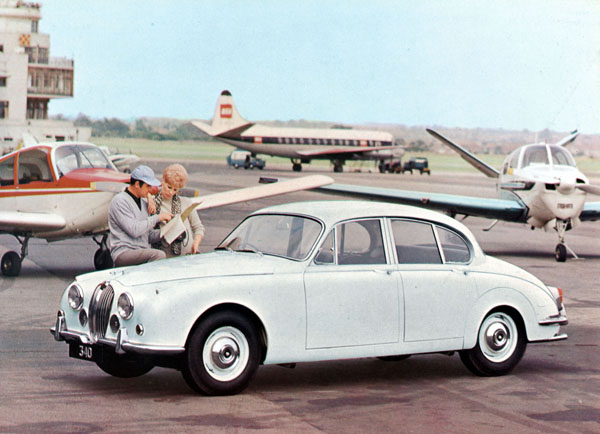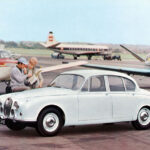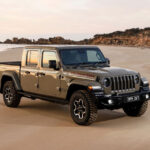 Towards the end of 1959 Jaguar expanded its range of cars with the release of the new Mark II saloons. This provided a range of ten basic models which also offered a choice of transmissions and disc or drum brakes for the standard 2.4 and 3.8 saloons, XK150 series body styles and a wide range of exterior and interior colour schemes.
Towards the end of 1959 Jaguar expanded its range of cars with the release of the new Mark II saloons. This provided a range of ten basic models which also offered a choice of transmissions and disc or drum brakes for the standard 2.4 and 3.8 saloons, XK150 series body styles and a wide range of exterior and interior colour schemes.
The Jaguar range at that time comprised the large and luxurious 3.8-litre Mark IX saloon, the 2.4 and 3.4 standard saloons and the 3.4 XK150 and 150S as before, together with the new Mark II 2.4, 3.4 and 3.8 saloons, with major body and mechanical changes. As well, they released an additional XK150 model using the new 3.8-litre engine.
Basically the specifications of the Mark II Jaguars resembled that of the standard models. The well known twin-overhead camshaft engine, coupled to a four-speed synchromesh or Borg-Warner automatic gear box, was installed in a four-door, all-steel, integral body and chassis structure. At the front there was an independent coil spring suspension, whilst at the rear long cantilever half-elliptical leaf springs were used. By altering the front suspension and widening the rear track superior suspension qualities and reduced corner roll were achieved.
Under the bonnet extra power was achieved in the 2.4-litre engine by fitting a different cylinder head with larger valves fitting into an angled seat. This head was developed from the famous D-type engine. The 2.4-litre engine had a twin Solex downdraught carburettor and a dual exhaust system employing two mufflers. For owners who wanted more performance either the 157kW 3.4-litre engine or the 164kW 3.8-litre engine were offered. Both had twin SU carburettors with automatic choke control and 254mm diameter clutches.
The body fitted to these Jaguars received high praise. The deep wide windscreen, wrap around rear window and narrow screen pillars for improved driver visibility came about following exhaustive laboratory tests. Plated frames were used for all the windows and roof guttering. Although the Mark II models bore a strong resemblance to their fellows in their exterior lines, many changes were made in the interior.
Redesigned front seats had a more comfortable and practical shape which gave the occupants more support. New seat designs with additional cushioning and folding central arm rests gave maximum comfort for occupants of the rear seat, who also had foot room under the front seats, and folding tables recessed into the back of the latter.
The 3.8-litre Mark II was the choice of many racing drivers for touring car racing but also behaved with impeccable manners for town or city motoring. The 3.8-litre unit was the same as used in the Mark IX saloon and in the S model was equipped with three SU carburettors to produce 350 Nm at 4000 rpm and 198 kW at 5500rpm.










